RENAULT CAPTUR 2014 1.G Owners Manual
Manufacturer: RENAULT, Model Year: 2014, Model line: CAPTUR, Model: RENAULT CAPTUR 2014 1.GPages: 244, PDF Size: 5.64 MB
Page 171 of 244
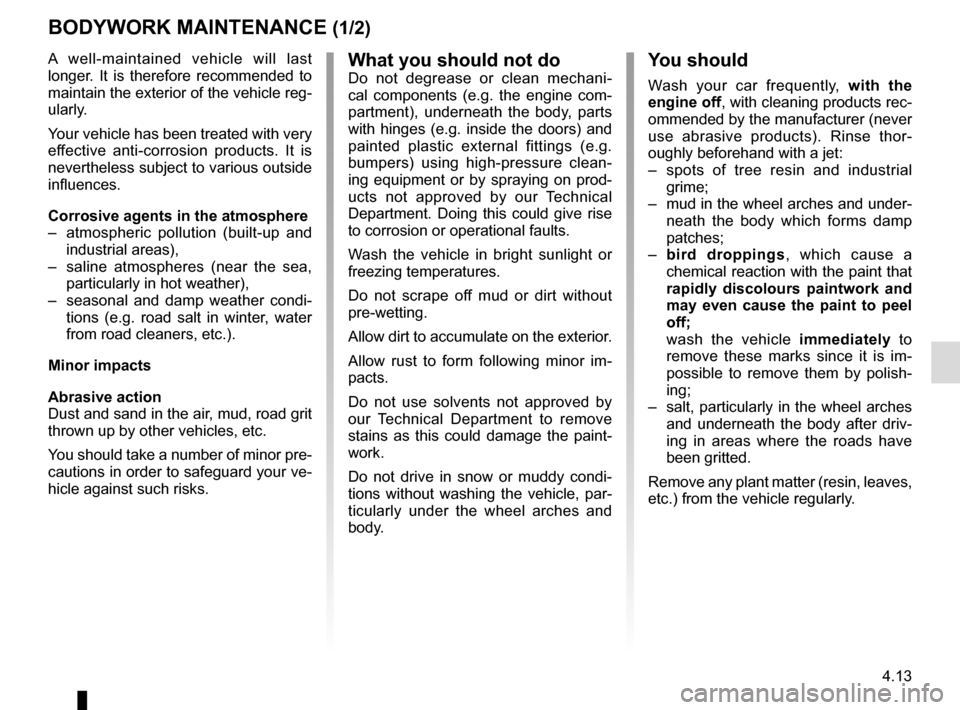
4.13
BODYWORK MAINTENANCE (1/2)
You should
Wash your car frequently, with the
engine off, with cleaning products rec-
ommended by the manufacturer (never
use abrasive products). Rinse thor-
oughly beforehand with a jet:
– spots of tree resin and industrial
grime;
– mud in the wheel arches and under-
neath the body which forms damp
patches;
– bird droppings , which cause a
chemical reaction with the paint that
rapidly discolours paintwork and
may even cause the paint to peel
off;
wash the vehicle immediately to
remove these marks since it is im-
possible to remove them by polish-
ing;
– salt, particularly in the wheel arches
and underneath the body after driv-
ing in areas where the roads have
been gritted.
Remove any plant matter (resin, leaves,
etc.) from the vehicle regularly.
What you should not doDo not degrease or clean mechani-
cal components (e.g. the engine com-
partment), underneath the body, parts
with hinges (e.g. inside the doors) and
painted plastic external fittings (e.g.
bumpers) using high-pressure clean-
ing equipment or by spraying on prod-
ucts not approved by our Technical
Department. Doing this could give rise
to corrosion or operational faults.
Wash the vehicle in bright sunlight or
freezing temperatures.
Do not scrape off mud or dirt without
pre-wetting.
Allow dirt to accumulate on the exterior.
Allow rust to form following minor im-
pacts.
Do not use solvents not approved by
our Technical Department to remove
stains as this could damage the paint-
work.
Do not drive in snow or muddy condi-
tions without washing the vehicle, par-
ticularly under the wheel arches and
body.
A well-maintained vehicle will last
longer. It is therefore recommended to
maintain the exterior of the vehicle reg-
ularly.
Your vehicle has been treated with very
effective anti-corrosion products. It is
nevertheless subject to various outside
influences.
Corrosive agents in the atmosphere
–
atmospheric pollution (built-up and
industrial areas),
– saline atmospheres (near the sea,
particularly in hot weather),
– seasonal and damp weather condi-
tions (e.g. road salt in winter, water
from road cleaners, etc.).
Minor impacts
Abrasive action
Dust and sand in the air, mud, road grit
thrown up by other vehicles, etc.
You should take a number of minor pre-
cautions in order to safeguard your ve-
hicle against such risks.
Page 172 of 244
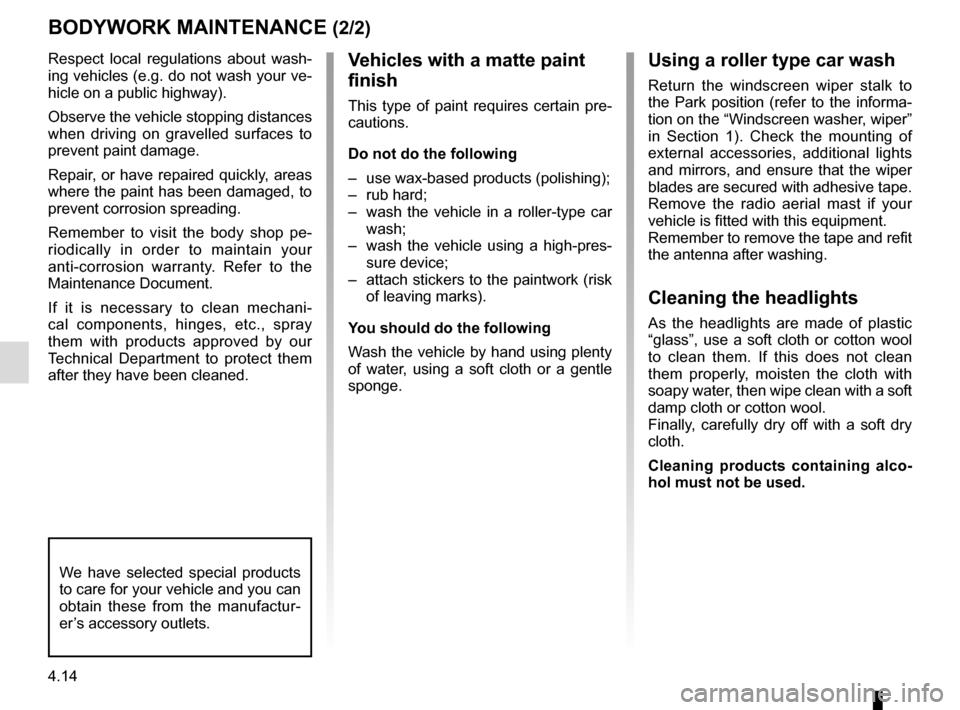
4.14
Respect local regulations about wash-
ing vehicles (e.g. do not wash your ve-
hicle on a public highway).
Observe the vehicle stopping distances
when driving on gravelled surfaces to
prevent paint damage.
Repair, or have repaired quickly, areas
where the paint has been damaged, to
prevent corrosion spreading.
Remember to visit the body shop pe-
riodically in order to maintain your
anti-corrosion warranty. Refer to the
Maintenance Document.
If it is necessary to clean mechani-
cal components, hinges, etc., spray
them with products approved by our
Technical Department to protect them
after they have been cleaned.
BODYWORK MAINTENANCE (2/2)
We have selected special products
to care for your vehicle and you can
obtain these from the manufactur-
er’s accessory outlets.
Using a roller type car wash
Return the windscreen wiper stalk to
the Park position (refer to the informa-
tion on the “Windscreen washer, wiper”
in Section 1). Check the mounting of
external accessories, additional lights
and mirrors, and ensure that the wiper
blades are secured with adhesive tape.
Remove the radio aerial mast if your
vehicle is fitted with this equipment.
Remember to remove the tape and refit
the antenna after washing.
Cleaning the headlights
As the headlights are made of plastic
“glass”, use a soft cloth or cotton wool
to clean them. If this does not clean
them properly, moisten the cloth with
soapy water, then wipe clean with a soft
damp cloth or cotton wool.
Finally, carefully dry off with a soft dry
cloth.
Cleaning products containing alco-
hol must not be used.
Vehicles with a matte paint
finish
This type of paint requires certain pre-
cautions.
Do not do the following
– use wax-based products (polishing);
– rub hard;
– wash the vehicle in a roller-type car
wash;
– wash the vehicle using a high-pres-
sure device;
– attach stickers to the paintwork (risk
of leaving marks).
You should do the following
Wash the vehicle by hand using plenty
of water, using a soft cloth or a gentle
sponge.
Page 173 of 244
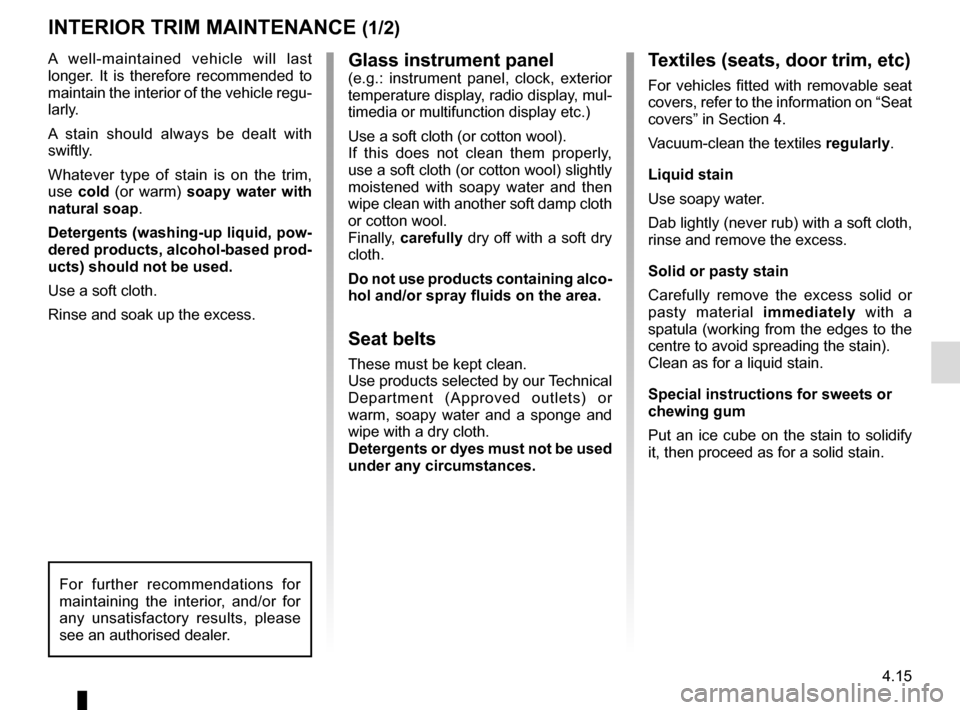
4.15
Glass instrument panel(e.g.: instrument panel, clock, exterior
temperature display, radio display, mul-
timedia or multifunction display etc.)
Use a soft cloth (or cotton wool).
If this does not clean them properly,
use a soft cloth (or cotton wool) slightly
moistened with soapy water and then
wipe clean with another soft damp cloth
or cotton wool.
Finally, carefully dry off with a soft dry
cloth.
Do not use products containing alco-
hol and/or spray fluids on the area.
Seat belts
These must be kept clean.
Use products selected by our Technical
Department (Approved outlets) or
warm, soapy water and a sponge and
wipe with a dry cloth.
Detergents or dyes must not be used
under any circumstances.
INTERIOR TRIM MAINTENANCE (1/2)
Textiles (seats, door trim, etc)
For vehicles fitted with removable seat
covers, refer to the information on “Seat
covers” in Section 4.
Vacuum-clean the textiles regularly.
Liquid stain
Use soapy water.
Dab lightly (never rub) with a soft cloth,
rinse and remove the excess.
Solid or pasty stain
Carefully remove the excess solid or
pasty material immediately with a
spatula (working from the edges to the
centre to avoid spreading the stain).
Clean as for a liquid stain.
Special instructions for sweets or
chewing gum
Put an ice cube on the stain to solidify
it, then proceed as for a solid stain.
A well-maintained vehicle will last
longer. It is therefore recommended to
maintain the interior of the vehicle regu-
larly.
A stain should always be dealt with
swiftly.
Whatever type of stain is on the trim,
use
cold (or warm) soapy water with
natural soap.
Detergents (washing-up liquid, pow-
dered products, alcohol-based prod-
ucts) should not be used.
Use a soft cloth.
Rinse and soak up the excess.
For further recommendations for
maintaining the interior, and/or for
any unsatisfactory results, please
see an authorised dealer.
Page 174 of 244
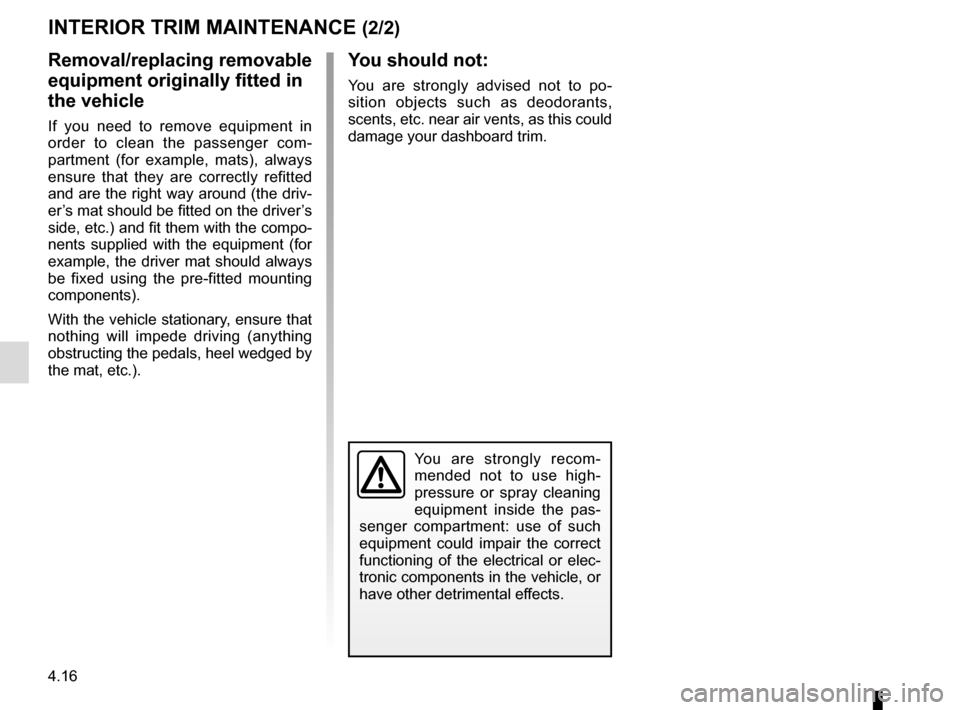
4.16
You are strongly recom-
mended not to use high-
pressure or spray cleaning
equipment inside the pas-
senger compartment: use of such
equipment could impair the correct
functioning of the electrical or elec-
tronic components in the vehicle, or
have other detrimental effects.
INTERIOR TRIM MAINTENANCE (2/2)
You should not:
You are strongly advised not to po-
sition objects such as deodorants,
scents, etc. near air vents, as this could
damage your dashboard trim.
Removal/replacing removable
equipment originally fitted in
the vehicle
If you need to remove equipment in
order to clean the passenger com-
partment (for example, mats), always
ensure that they are correctly refitted
and are the right way around (the driv-
er’s mat should be fitted on the driver’s
side, etc.) and fit them with the compo-
nents supplied with the equipment (for
example, the driver mat should always
be fixed using the pre-fitted mounting
components).
With the vehicle stationary, ensure that
nothing will impede driving (anything
obstructing the pedals, heel wedged by
the mat, etc.).
Page 175 of 244
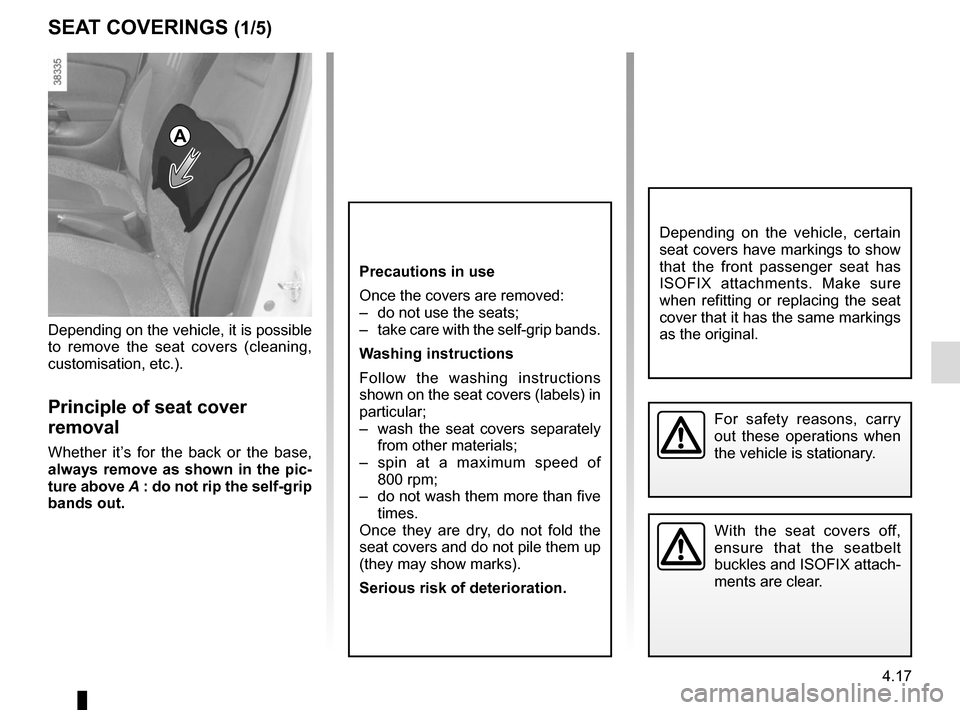
4.17
SEAT COVERINGS (1/5)
Depending on the vehicle, it is possible
to remove the seat covers (cleaning,
customisation, etc.).
Principle of seat cover
removal
Whether it’s for the back or the base,
always remove as shown in the pic-
ture above A : do not rip the self-grip
bands out.
Precautions in use
Once the covers are removed:
– do not use the seats;
– take care with the self-grip bands.
Washing instructions
Follow the washing instructions
shown on the seat covers (labels) in
particular;
– wash the seat covers separately from other materials;
– spin at a maximum speed of 800 rpm;
– do not wash them more than five times.
Once they are dry, do not fold the
seat covers and do not pile them up
(they may show marks).
Serious risk of deterioration.
For safety reasons, carry
out these operations when
the vehicle is stationary.
A
With the seat covers off,
ensure that the seatbelt
buckles and ISOFIX attach-
ments are clear.
Depending on the vehicle, certain
seat covers have markings to show
that the front passenger seat has
ISOFIX attachments. Make sure
when refitting or replacing the seat
cover that it has the same markings
as the original.
Page 176 of 244
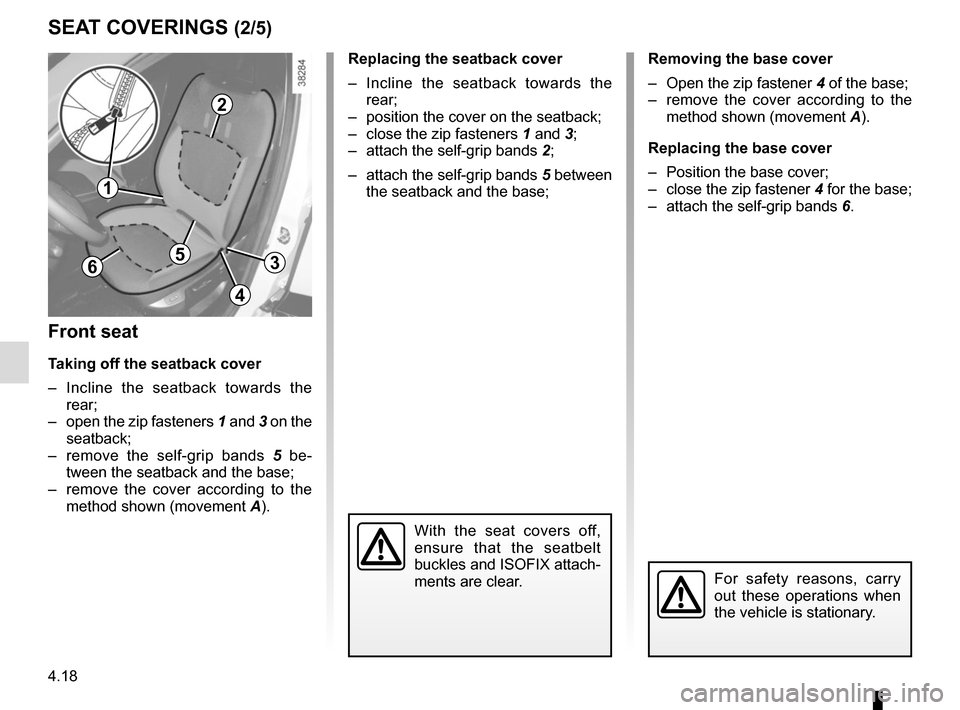
4.18
4
SEAT COVERINGS (2/5)
For safety reasons, carry
out these operations when
the vehicle is stationary.
6
Removing the base cover
– Open the zip fastener 4 of the base;
– remove the cover according to the method shown (movement A).
Replacing the base cover
– Position the base cover;
– close the zip fastener 4 for the base;
– attach the self-grip bands 6.
Replacing the seatback cover
– Incline the seatback towards the
rear;
– position the cover on the seatback;
– close the zip fasteners 1 and 3;
– attach the self-grip bands 2;
– attach the self-grip bands 5 between
the seatback and the base;
35
1
2
Front seat
Taking off the seatback cover
– Incline the seatback towards the rear;
– open the zip fasteners 1 and 3 on the
seatback;
– remove the self-grip bands 5 be-
tween the seatback and the base;
– remove the cover according to the method shown (movement A).
With the seat covers off,
ensure that the seatbelt
buckles and ISOFIX attach-
ments are clear.
Page 177 of 244
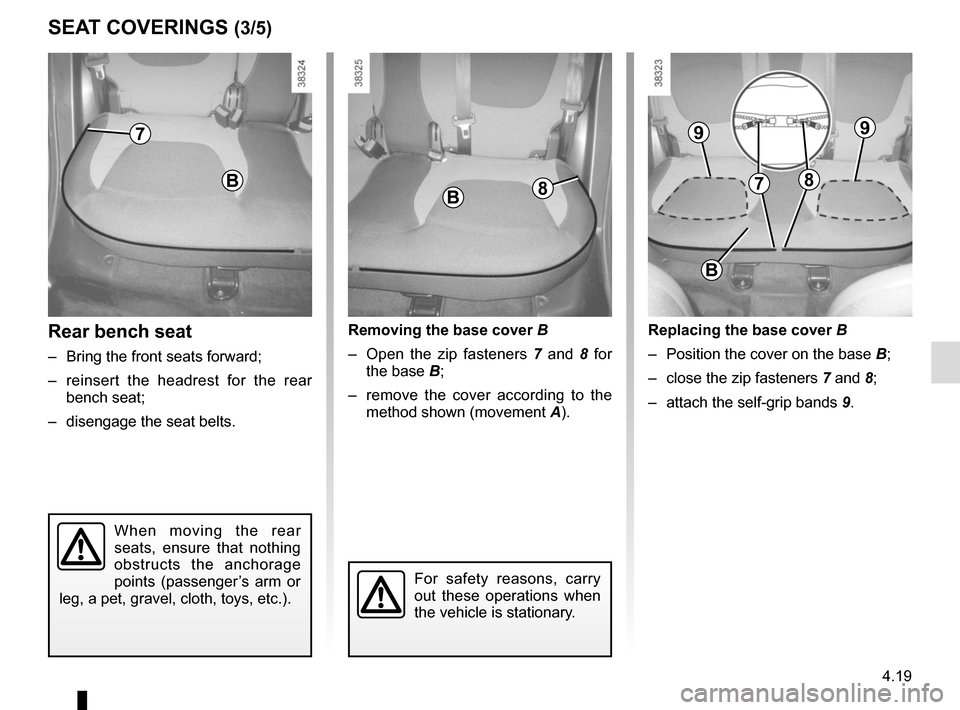
4.19
Rear bench seat
– Bring the front seats forward;
– reinsert the headrest for the rear bench seat;
– disengage the seat belts.
When moving the rear
seats, ensure that nothing
obstructs the anchorage
points (passenger’s arm or
leg, a pet, gravel, cloth, toys, etc.).
Removing the base cover B
– Open the zip fasteners 7 and 8 for
the base B;
– remove the cover according to the method shown (movement A).
For safety reasons, carry
out these operations when
the vehicle is stationary.
Replacing the base cover B
– Position the cover on the base B;
– close the zip fasteners 7 and 8;
– attach the self-grip bands 9.
SEAT COVERINGS (3/5)
78
99
B
7
8BB
Page 178 of 244
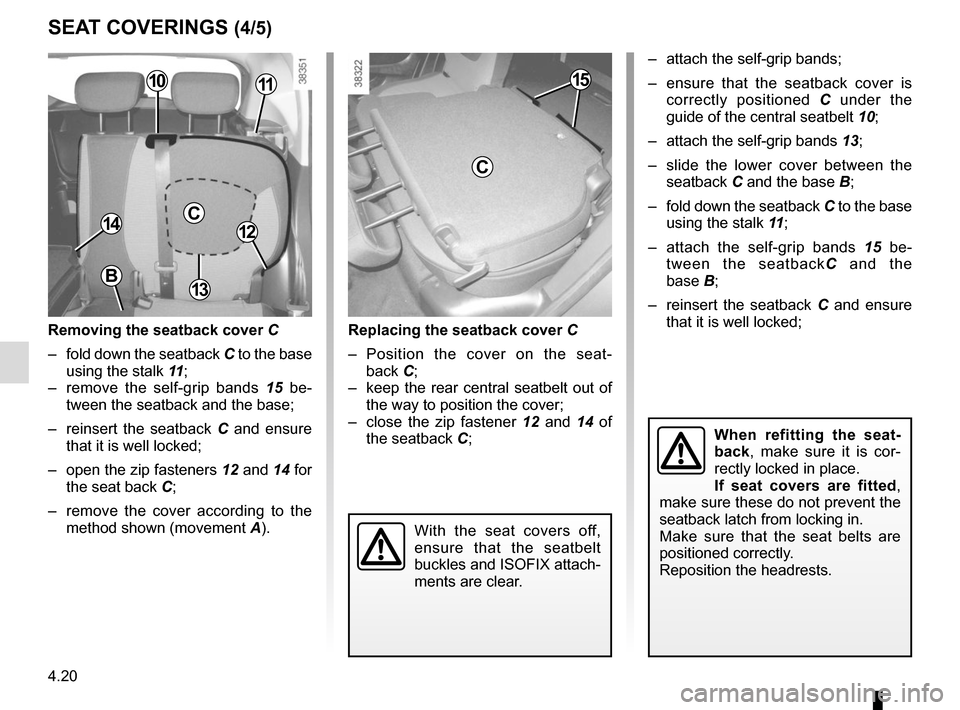
4.20
SEAT COVERINGS (4/5)
Removing the seatback cover C
– fold down the seatback C to the base
using the stalk 11 ;
– remove the self-grip bands 15 be-
tween the seatback and the base;
– reinsert the seatback C and ensure
that it is well locked;
– open the zip fasteners 12 and 14 for
the seat back C;
– remove the cover according to the method shown (movement A).
C1412
1115
C
Replacing the seatback cover C
– Position the cover on the seat- back C;
– keep the rear central seatbelt out of the way to position the cover;
– close the zip fastener 12 and 14 of the seatback C; – attach the self-grip bands;
– ensure that the seatback cover is
correctly positioned C under the
guide of the central seatbelt 10;
– attach the self-grip bands 13;
– slide the lower cover between the seatback C and the base B;
– fold down the seatback C to the base
using the stalk 11 ;
– attach the self-grip bands 15 be-
tween the seatback C and the
base B;
– reinsert the seatback C and ensure
that it is well locked;
10
13
When refitting the seat-
back, make sure it is cor-
rectly locked in place.
If seat covers are fitted ,
make sure these do not prevent the
seatback latch from locking in.
Make sure that the seat belts are
positioned correctly.
Reposition the headrests.
B
With the seat covers off,
ensure that the seatbelt
buckles and ISOFIX attach-
ments are clear.
Page 179 of 244
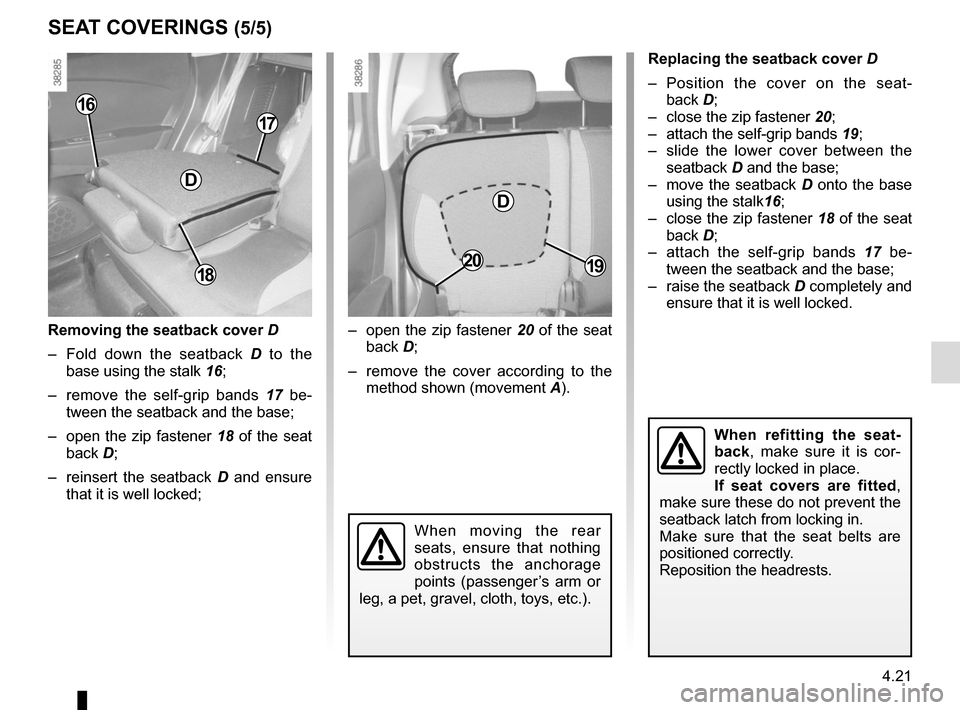
4.21
Replacing the seatback cover D
– Position the cover on the seat- back D;
– close the zip fastener 20;
– attach the self-grip bands 19;
– slide the lower cover between the seatback D and the base;
– move the seatback D onto the base using the stalk 16;
– close the zip fastener 18 of the seat
back D;
– attach the self-grip bands 17 be-
tween the seatback and the base;
– raise the seatback D completely and ensure that it is well locked.
SEAT COVERINGS (5/5)
– open the zip fastener 20 of the seat
back D;
– remove the cover according to the method shown (movement A).
20
D
18
17
D
16
Removing the seatback cover D
– Fold down the seatback D to the
base using the stalk 16;
– remove the self-grip bands 17 be-
tween the seatback and the base;
– open the zip fastener 18 of the seat
back D;
– reinsert the seatback D and ensure
that it is well locked;
19
When moving the rear
seats, ensure that nothing
obstructs the anchorage
points (passenger’s arm or
leg, a pet, gravel, cloth, toys, etc.).
When refitting the seat-
back, make sure it is cor-
rectly locked in place.
If seat covers are fitted ,
make sure these do not prevent the
seatback latch from locking in.
Make sure that the seat belts are
positioned correctly.
Reposition the headrests.
Page 180 of 244
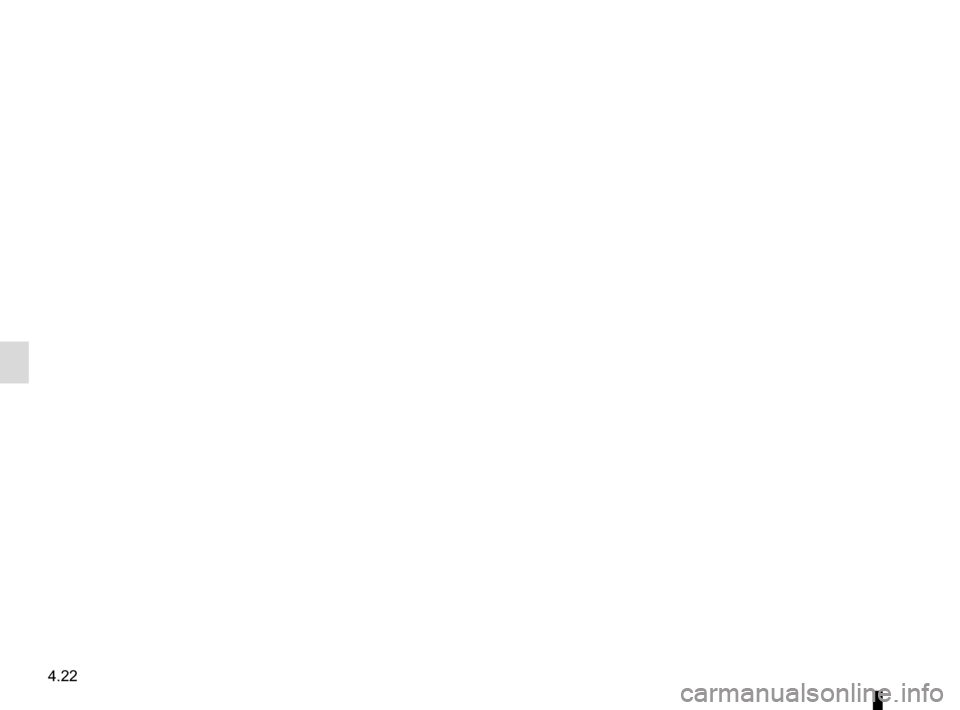
4.22